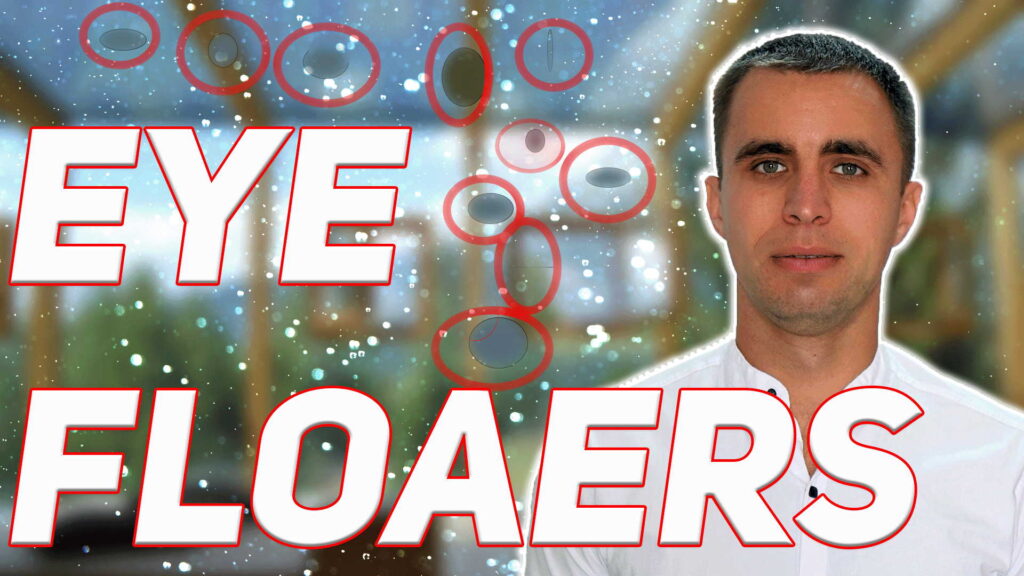How to reduce eye floaters and flashes? What are eye floaters in the eyes? If you look, for example, at a bright ceiling or at the sky on a sunny day, you can see small muddy floating flies or sticks or dots in the eyes. If, for example, you raise your eyes up, their position changes, and they seem to float.

How dangerous are eye floaters?
There is nothing terrible in them. These are various small blood clots or various detached particles of the inner surface of the eye. For example, with myopia, the eyeball is squeezed in the middle by spasmodic oblique muscles of the eye, and the retina is constantly in a compressed state of tension, and a small part could detach.
Eye floaters and flashes are usually harmless and do not require treatment. But, they can be annoying and interfere with your daily activities.

how to reduce eye floaters and flashes
There is nothing to do with them. Regular exercises to lightly stretch the eye muscles will help improve blood circulation and eye regeneration. Improved blood circulation helps to remove various toxins from the body. As well it helps to dissolve some kinds of clots. It is better to get rid of the spasms of the eye muscles to restore the normal functioning of the eyes and keep the eyes in a relaxed state.

Eye Training Course Eyesight Academy can help you to train your eyes without mistakes in technique. Eye training will increase blood flow in your eyes nutrient digestion and the eye floater’s dissolving process.
Do gentle massage of your temples. Massaging your temples can help relax your eye muscles and reduce stress levels, which can trigger eye floaters and flashes.
Or you can try an eye massager to relieve eye fatigue and get better vision.
Avoid Eye strain to reduce eye floaters and flashes

Eye strain can worsen eye floaters and flashes by causing inflammation and irritation in your eyes. To avoid eye strain, limit your screen time, take frequent breaks from reading or working, adjust the brightness and contrast of your screen, use proper lighting, and wear sunglasses when outdoors.
Understanding Eye Floaters’ Realities
Eye floaters are a common phenomenon experienced by many individuals at some point in their lives. Characterized by small, shadowy figures that drift through one’s field of vision, floaters can appear as spots, threads, or fragments of cobwebs. Often, they are more noticeable when looking at a plain, bright background, such as a clear sky or a white wall. While they may seem alarming at first, understanding their nature and causes can help demystify their presence and reduce undue worry.
The Nature of Eye Floaters
Eye floaters are typically caused by age-related changes that occur within the eye’s vitreous humor—the gel-like substance that fills the majority of the eye’s interior. Over time, the vitreous partially liquefies and can separate from the interior surface of the eye. This process can lead to the formation of tiny clumps or strands within the eye, casting shadows on the retina that are perceived as floaters.
Myopic Eye Floaters nature
In some cases, especially in individuals with myopia (nearsightedness), the eye’s elongated shape can cause additional tension on the vitreous humor and the retina. This tension might lead to the detachment of small particles or even blood clots, which then become visible as floaters.
Are Eye Floaters Dangerous?
For the most part, eye floaters are more of a nuisance than a danger. They are a natural part of the eye’s aging process and do not usually signify any serious underlying condition. However, a sudden increase in floaters, especially if accompanied by flashes of light or a shadow appearing in your peripheral vision, could indicate a retinal detachment—a serious condition that requires immediate medical attention.
Reducing Eye Floaters and Flashes
While there is no direct cure for eye floaters, there are several strategies that can help manage their presence and reduce their impact on your daily life:
- Regular Eye Exercises: Engaging in Eye exercises that promote eye relaxation and flexibility can help. These might include focusing exercises that stretch the eye muscles gently and reduce tension.
- Stay Hydrated: Adequate hydration is essential for maintaining the health of the vitreous humor, potentially reducing the formation of floaters.
- Minimize Screen Time: Excessive use of screens can strain the eyes and exacerbate the visibility of floaters.
- Dietary Adjustments: A diet rich in antioxidants can support overall eye health. Vitamins C and E, lutein, and zeaxanthin are particularly beneficial for maintaining the health of the eye’s vitreous and retina.
- Medical Consultation: If floaters become a significant hindrance or if you notice a sudden increase in their number, consulting an eye care professional is crucial. They can assess whether the floaters are a symptom of an underlying condition that requires treatment.
Conclusion
While eye floaters can be an annoying distraction, they are usually not a cause for alarm. Understanding their benign nature can alleviate much of the concern associated with their appearance. However, maintaining good eye health through regular check-ups, proper hydration, balanced nutrition, and appropriate eye care practices is essential in managing floaters and ensuring overall ocular well-being. If ever in doubt, or if changes in vision are observed, seeking professional advice is always the best course of action.
- How to Improve Your Eye Health & Offset Vision Loss: A Comedy of Errors
- How to Manage Astigmatism Naturally: A Comprehensive Guide
- How to get rid of under-eye bags Naturally? Top 10 Strategies for a Refreshed Look
- 5 Best Foods to Get Better Eye Health and Vision
- Top 10 Essential Facts You Need to Know About Eye Floaters

